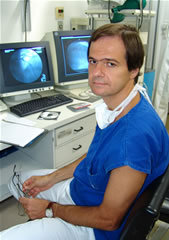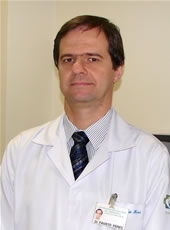 |

|
 |
Dr. Fausto Feres is the Director
of Invasive Cardiology at Instituto Dante Pazzanese de Cardiologia
in São Paulo, Brazil, a pioneering interventional cardiology
hospital where in 1999 Prof J. Eduardo Sousa began the first-in-man
trials of the CYPHER sirolimus-eluting stent. Dr. Feres has
many publications to his credit and speaks regularly at the
major international cardiology meetings. He is the principal
investigator for a new clinical trial, dubbed OPTIMIZE, a.k.a.
OPTIMIzed Duration of Clopidogrel Therapy Following Treatment
with the Endeavor Zotarolimus-Eluting Stent (ZES) in the "Real
World".
In this exclusive interview, Dr. Feres explains the novel
nature of this 3,000 patient trial which is measuring
patient outcomes after only three months of dual antiplatelet
therapy
when
used with
Medtronic's Endeavor ZES. OPTIMIZE is unique because, due to
concerns over late stent thrombosis, other trials are testing
periods of one to three years -- Dr. Feres' hypothesis is that
the Endeavor zotarolimus-eluting stent heals more quickly and
therefore patients do not need to be taking aspirin plus Plavix
for more than three months. If borne out, these finding could
have important implications for cost-savings as well as patient
safety. |
|

photo of
Fausto Feres, MD
© Sérgio
Savaman Savarese |

Instituto
Dante Pazzanese de
Cardiologia, São Paulo, Brazil |
|
Q: Why did you decide
to do this trial?
Dr. Feres: We started using the Endeavor stent
here in our country in 2006 when it was approved. We were in
the E-Five
Registry.
We included 100 patients in that registry, but we decided to
do intravascular ultrasound (IVUS) in all patients: before the
procedure, after the procedure and at the angio follow-up at
least six months later.
When we did the intravascular ultrasound after the procedure,
six months later, we started seeing a complete apposition of
the stent. We did not see positive remodeling, no late malapposition,
or acquired malapposition with the Endeavor stent. |
We had had previous
experience with Cypher and Taxus and we published that in the
European Heart Journal almost
two years ago. In almost 200 patients, we found like 5.6 or
5.7% of late malapposition, with both Cypher and Taxus. In 2004 we
had
also seen patients with late thrombosis after Cypher and Taxus
and we published those cases in 2006 that late thrombosis was related
to late malapposition, a huge malapposition. So in our opinion,
at that time, was that there was a strong correlation between late
stent malapposition and late stent thrombosis.
Q: There was a recent study out of Berne calling attention to this.
Dr. Feres: Actually there were two studies from Switzerland. The
first one was May
2007 by Stéphane Cook, the first author,
and he published that 77% of late thrombosis had late malapposition
-- so, 9 or 10 patients out of 13. Now recently they published
again. This time they did aspiration of the thrombus and found
some inflammatory cells inside of the stent with late malapposition.
And again they found 73% of patients with late malapposition also
had late thrombosis.
When we started studying
the Endeavor stent we did not see late malapposition. Even when
we had some acute malapposition, this was resolved after six
months, probably because of the intimal hyperplasia. We prescribed
the dual antiplatelet regimen for our patients only for three
months, because they said that we could do that. Endeavor I was
like this, Endeavor II, even Endeavor III: no more than three
months of DAPT (Dual Antiplatelet Therapy). And Endeavor IV was
six months because it was randomized against Taxus.
But we did
not see late malapposition with Endeavor and we did not see
late thrombosis with this kind of stent. Now we have almost
400 patients
with the Endeavor stent and we have not seen late thrombosis. |
|

Endeavor
zotarolimus-
eluting stent |
What's so
curious is to have only three
months of antiplatelet therapy, because we have the recommendation
of FDA, the guidelines, AHA and ACC, that we should use twelve months
for all kinds of stents. But all stents are not the same!
So
that's our hypothesis, maybe we should change that. But we need
to prove
it. So we have the objective for this OPTIMIZE study: to do a comparison
and to prove that with only three months of DAPT after the Endeavor
stent vs. twelve months, we could have similar results, or even
better with the three months because we could avoid bleeding complications
from DAPT. Why twelve months? Because we have this data – well,
not data, but just personal experience or some recommendations
by the FDA panel and the ACC and the AHA.
Q: Right, in fact there is no data, because the FDA and ACC don't
really know, they don't have any scientific reason for saying twelve
months.
Dr. Feres: Exactly. They just did that because of the firestorm about
stent thrombosis in 2006.
Q: I was at the FDA hearings in 2006 and Antonio Colombo testified
that his data showed that there was no measureable benefit to clopidogrel
after six months.
Dr. Feres: Yes. And if you look at more recent studies like this
PLATO with ticagrelor vs. clopidogrel, if you look at the curves
of severe bleeding, after the first month you have 5 or 6 % of severe
bleeding. The total bleeding was 11% in each group! After the first
month, patients that took clopidogrel for at least twelve months
and ticagrelor it was 6% with severe bleeding, that's too high. The
patient doesn't need to have these kinds of drugs for such long periods.
Q: How many patients are you enrolling, or planning to enroll?
Dr. Feres: Here's how we calculate the sample size. The first endpoint
is going to be a hard endpoint. We're not talking about TLR or
TVR; we're talking about death, MI, stroke and severe bleeding.
We decided to have these four hard endpoints and we're going to
combine them. And we estimate by the E-Five data that we are going
to get maybe 8 or 9% at the end of one year. So to get the p-value
up to less than .005 we're going to need like maybe 1,600 patients
for each group. So it's going to be 3,200 patients, only with the
Endeavor stent.
Q: How many centers are involved in this?
Dr. Feres: We are going to have about 30 centers, an average of 10
patients per center per month, so we estimate that we can finish
the trial in one year.
Q: This isn't on clinicaltrials.gov yet?
Dr. Feres: Not yet, we're just finalized the protocol because we
need to make a lot of changes even for the FDA requirements and
even here in Brazil. It's not easy to do a large trial like this
because there is a lot of money involved. It's going to be a physicians’ initiative,
totally independent from the company. The company is going to support
this but we are going to use the Cardiovascular Research Center
here in Brazil that's conducted by Alex Abizaid and we are going
to manage the data. Medtronic is going to support the trial, but
the data belongs to us, it's totally independent.
We have the guidelines for acute coronary syndrome; people are oriented
to prescribe Plavix for twelve months, for one year. We think we
can do that just for three months, that's going to be enough even
for ACS patients. Because we have only one trial, the CURE trial,
that was performed 10 years ago, published in 2001; maybe we can
just see if we really need to prescribe Plavix for one year for patients
with ACS.
Q: You're thinking it can be shorter?
Dr. Feres: Patients with ACS will be included in this trial. We are
going to exclude only primary PCI for acute ST-elevation, bypass
grafts and DES in-stent restenosis.

Dr. Fausto
Feres |
|
Q: What are the implications
of a trial like this? If the hypothesis is proven what are the
implications for patient outcomes, safety and cost savings?
Dr.
Feres: If you prove that twelve months is superior to three months,
we need to forget about giving three months of clopidogrel to patients.
But if we find they are similar, twelve months vs. three months,
then we can save money -- if patients don't need to take Plavix for
an extra nine months, that's a lot of money, and they can avoid some
bleeding complications, I'd say at least between 3 and 5% of severe
bleeding complications. The patients that need surgery, abdominal
surgery, or even for eye surgery, we have a problem with those patients
because they say, "Oh I cannot stop Plavix and I need to have surgery".
Even if they go to the dentist, they say they cannot stop Plavix,
so that's a very good implication.
I think if we can prove that we don't need Plavix for
one year, that just three months is enough, three months can be
clinically superior, if you can have
less bleeding and less cost, that's going to be a very positive trial for the
Endeavor stent. And if we can extrapolate this for other DES…. |
Q: Could these results apply to other
stents besides zotarolimus?
Dr. Feres: Yes, maybe we can just go to Resolute -- that’s
the next generation for Endeavor. I don't know if people from Abbott
or Boston Scientific with Xience and Promus, because of late thrombosis
being lower with this kind of stent, maybe. I would not do this with
Taxus and Cypher, because we have seen some late thrombosis between
three and twelve months in patients that are not taking clopidogrel.
But I would say for the second generation of DES we can extend that,
I think this is going to be very important.
Q: Dr. Guagliumi from Bergamo, Italy
has presented some very interesting OCT slides showing the healing
differences inside of the Cypher,
Taxus and the Endeavor. The fact there is better coverage with the
Endeavor, the fact that it's more homogenous, has this affected
your sense
that this
might be safe?
Dr. Feres: Yes. There is also some data with OCT from Japan and there
is also some that was presented during the last PCR from Korea: they
took patients that stopped clopidogrel at three months and compared
with twelve months and the patients at three months were at least
the same, they got the same result.
Q: In terms of coverage and healing?
Dr. Feres: Yes
Q: One of the criticisms of the zotarolimus stent, the Endeavor,
is that it is not as robust in terms of anti-proliferation as the
other DES; that late lumen loss is greater. Is there a relationship
between increased late lumen loss and healing and late stent thrombosis
that you've found?
Dr. Feres: No. I really don't think so. Doctors think it's because
of that, because of late lumen loss. I don't think there is any kind
of relation between late lumen loss and late thrombosis. I think
it's because of late incomplete stent apposition. I think it's proved
that it's lower with the Endeavor. If we look at the data for the
Endeavor III, I have slides of this that were published last year,
they found that with Cypher 5.9% late incomplete apposition and with
the Endeavor it was like 0.5%.
Q: Do you think the cause is the drug or perhaps the polymer?
Dr. Feres: I think it's because of the polymer for sure. Because
the polymer in the Endeavor stent is a PC, which is a durable polymer,
we have seen in experimental studies by Renu Virmani, the inflammation
scores are quite low, lower than Cypher and Taxus and similar to
a bare metal stent. So I think the polymer plays a role for late
thrombosis.
Q: Interestingly, during her talk at this past TCT meeting, Dr.
Virmani stated that if she was having an MI, she would want her cardiologist
to use an Endeavor stent!
Dr. Feres: We don't have data for this, but I do that for my patients,
so I feel really secure if I place an Endeavor. But if we have a
patient with higher chance of restenosis, for example with small
vessel diabetes, maybe an Endeavor stent is not the best stent --
we need to have a stent that decreases intimal hyperplasia more strongly.
Q: Maybe the Xience?
Dr. Feres: The Xience, or Promus or even the Resolute. That's what
I do in my practice.
Q: What are the current protocols that you have been using for dual
antiplatelet therapy, how many months normally?
Dr. Feres: I try to follow the rules. For the Endeavor I use three
months; for other stents, twelve months. For some patients with the
bifurcation where I used Cypher in the past, or something, I try
to keep forever. No data for this, but just for my conscience.
Q: There's another study that's being done at Scripps called SEASIDE.
They're testing the Endeavor at six months, as opposed to three,
and they are going to be doing genotyping as well, which is going
to be very interesting, to see if there is a marker for platelet
reactivity.
Dr. Feres: Yes, I think six months is because the FDA requires that,
they cannot use it for only three months. We had the idea when we
did that, I talked to David Kandzari one year ago. I sent him my
protocol and we tried to do something together, to have a pooled
analysis after we have those very important studies. They also are
going to use only Endeavor. I think it’s very important in
six months. Maybe we can have some data together and be strong. There
is another one in Germany called ISAR-SAFE. They have published in
the American Heart Journal; they are going to use in 6,000 patients,
six months of clopidogrel vs. twelve months. But they are going to
use all kinds of stents.
Q: The other big dual antiplatelet therapy study is the DAPT study
which is just getting under way in this country which is going to
be all of the stents pooled together. They're just looking at 12
and 30 months. Do you have any comment on that?
Dr. Feres: That's going to be a huge study, all the companies are
involved. Maybe this is going to be the final answer in the U.S.
They are going to use all kinds of stents, but the problem is, all stents
are not the same. They are not equal, that's the real problem
in my opinion.
Q: And there are going to be more stents coming in the future.
Dr. Feres: Yes, exactly -- biodegradable polymers and bioabsorbable
polymers. We have, here in Brazil, we have two stents approved:
the Nobori, which is a bioabsorbable polymer and the Biomatrix
by Biosensor, both of them with biolomus and biodegradable polymers.
Q: Back to the OPTIMIZE trial, when do you see enrollment beginning?
Dr. Feres: We were supposed to start in October, but we have some
regulatory requirements here so we are going to try to do this
maybe at the end of December, the first week of January, we'll
start enrolling the patients. All the centers are prepared for
this. It's only in Brazil and I have tried to choose very good
centers because the data needs to be very strong, the procedures
need to be very well done and the patients need to be very well
followed. So I think it’s a very important question we have
and I'm trying to answer it for the community.
This interview was conducted in November 2009
by Burt Cohen of Angioplasty.Org.
|




